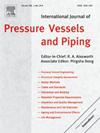基于charpy冲击的SA 508核部件大锻件参考温度T0的实验验证及基于charpy的断裂韧性下限曲线的建立
IF 3
2区 工程技术
Q2 ENGINEERING, MECHANICAL
International Journal of Pressure Vessels and Piping
Pub Date : 2025-05-05
DOI:10.1016/j.ijpvp.2025.105544
引用次数: 0
摘要
最近,利用Charpy冲击试验和半经验相关性,已经成功地应用于各种反应堆压力容器材料,实现了可靠的断裂韧性估计。此外,将输入参数的数量减少到韧脆转变温度和上架能量,得出了一个有意义的参考温度T0,该温度与根据E1921标准进行的实际断裂韧性试验确定的参考温度非常接近。然而,每种材料和条件的测试样本数量通常很少,通常在Charpy冲击和断裂韧性测试中各约12个样本,导致显著的散射带,假设95%的置信度为±43°C。在目前的工作中,相关性应用于一系列24个A508 Cl.3重型锻件,其中有大量的试验样品可用。结果证实了该关系式不仅与断裂韧性有关,而且与夏比冲击试验得出的参考温度有关,散射带减小到±21℃,表明所应用的公式非常适合估计大型非均质锻件的参考温度。此外,仅基于T41J也能推导出断裂韧性下限曲线,较好地包络了实验测量的断裂韧性数据,覆盖率达99%以上。本文章由计算机程序翻译,如有差异,请以英文原文为准。
Experimental validation of the Charpy-impact based reference temperature T0 of SA 508 heavy forgings of nuclear components and development of a Charpy-based fracture toughness lower bound curve
A reliable estimate of fracture toughness has recently been achieved using Charpy impact tests and a semi-empirical correlation that was successfully applied to various reactor pressure vessel materials. Moreover, the number of input parameters was reduced to the ductile-to-brittle transition temperature and upper shelf energy to derive a meaningful reference temperature T0 that is found to be in close agreement with the reference temperature determined from actual fracture toughness tests according to E1921 standard. However, the number of tested specimens for each material and condition is usually small, typically about 12 specimens each for the Charpy impact and fracture toughness tests, leading to a significant scatter band, of the order of ±43 °C assuming a 95 %-confidence level. In the present work, the correlation is applied to a series of 24 A508 Cl.3 heavy forgings for which a much larger number of test specimens is available. The results confirm the performance of the correlation with respect to fracture toughness but also with respect to the reference temperature derived from the Charpy impact tests and the scatter band is reduced to ±21 °C, showing that the applied formulae are very suitable for estimating the reference temperature for large inhomogeneous forgings. Moreover, the fracture toughness lower bound curve could also be derived based solely on T41J and envelops reasonably well the experimentally-measured fracture toughness data, covering more than 99 % of the data.
求助全文
通过发布文献求助,成功后即可免费获取论文全文。
去求助
来源期刊
CiteScore
5.30
自引率
13.30%
发文量
208
审稿时长
17 months
期刊介绍:
Pressure vessel engineering technology is of importance in many branches of industry. This journal publishes the latest research results and related information on all its associated aspects, with particular emphasis on the structural integrity assessment, maintenance and life extension of pressurised process engineering plants.
The anticipated coverage of the International Journal of Pressure Vessels and Piping ranges from simple mass-produced pressure vessels to large custom-built vessels and tanks. Pressure vessels technology is a developing field, and contributions on the following topics will therefore be welcome:
• Pressure vessel engineering
• Structural integrity assessment
• Design methods
• Codes and standards
• Fabrication and welding
• Materials properties requirements
• Inspection and quality management
• Maintenance and life extension
• Ageing and environmental effects
• Life management
Of particular importance are papers covering aspects of significant practical application which could lead to major improvements in economy, reliability and useful life. While most accepted papers represent the results of original applied research, critical reviews of topical interest by world-leading experts will also appear from time to time.
International Journal of Pressure Vessels and Piping is indispensable reading for engineering professionals involved in the energy, petrochemicals, process plant, transport, aerospace and related industries; for manufacturers of pressure vessels and ancillary equipment; and for academics pursuing research in these areas.

 求助内容:
求助内容: 应助结果提醒方式:
应助结果提醒方式:


